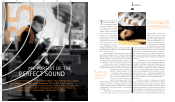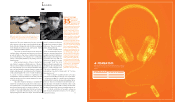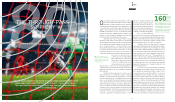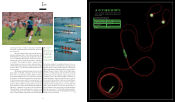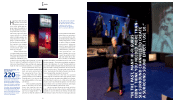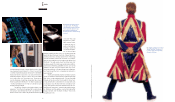Sennheiser 2012 Annual Report Download - page 15
Download and view the complete annual report
Please find page 15 of the 2012 Sennheiser annual report below. You can navigate through the pages in the report by either clicking on the pages listed below, or by using the keyword search tool below to find specific information within the annual report.
28
300 Hz
ARCHAEOACOUSTICS
To find out, Kolar played test signals from locations
near the monolith and in the depths of the gallery using
directional loudspeakers. As she hunted throughout the
ducts for specific types of sounds produced by every fre-
quency audible to humans (20 to 20,000 Hz), evenly spaced
omnidirectional microphones listened in. The results of the
data they delivered were amazing: the ancient ducts must
have made it possible for sounds emanating near the mono-
lith to be heard loud and clear by listeners in the ceremo-
nial plaza. Just what types of sounds did the ancients
make? Since conch-shell horns, known as pututus, appear in
much of the site iconography, Kolar’s team tested replica
pututus on site and also called on famous Peruvian musi-
cian Tito La Rosa to perform the instruments in museum
tests. Perry Cook led the Stanford team in measuring their
natural frequencies and recorded frequencies of around 300
Hz. “If you pass sound from all frequencies in the range of
human hearing through the ducts,” explains Kolar, “it is fas-
cinating to hear how the sounding-tone frequencies of the
Chavín pututus are amplified and high-frequency sounds
are drastically suppressed.” She suspects the ducts work as
filters, making any tone measured at 272 to 340 Hz sound
like these Chavín pututus.
Other research indicates that such low-frequency
sounds – low enough so that they could be felt as vibra-
tions as well as heard – could have provoked a sense of awe
in listeners standing in the plaza. This is because the
sounds produced by a conch shell are just as low as those
produced by a church organ, the sounds of which believers
can not only hear, but feel.
Assuming the decorated
stone monolith did serve as an oracle,
what was the oracle’s purpose? While
research is still ongoing, various find-
ings at the site hint at an answer. Ar-
chaeologists at Chavín have found
pictorial evidence of psychedelic
plants like the San Pedro cactus, tools
for grinding and mixing plant materi-
als, and representations of people
with mucus streaming out of their
noses – a typical side effect of us-
ing such drugs. The carvings on
the oracle statue, including fangs,
upturned eyes, and clawed hands
and feet, are similar to other carv-
ings found elsewhere on site and
in the region, indicating that the
statue featured distinctive, possi-
bly religious iconography that had
widespread influence.
Since Chavín’s acoustic
environment includes disorient-
ing, sound-distorting corridors as
well as ducts that amplify low-
frequency tones, it may have
served as the setting for a ritual or
ceremony during which people experienced plant-fueled
hallucinations. Such visitors may also have heard the
haunting low moans of voices or pututus emanating from
the oracle where the monolith is concealed. Kolar raves,
“We know there’s something extremely special about this
site. This is a place where people came to have an extraor-
dinary experience.” Her team believes priests or other
high-ranking officials may have used the oracle to convey
messages to visitors outside.
Kolar hopes to continue her work at Chavín, but she
also aims to go to other locations to conduct research into
other unexplained acoustical phenomena. In the past, she
has investigated the sound of Istanbul’s Hagia Sophia, the
largest and grandest church of sixth-
century Byzantium. For the future,
sites such as Hopi kiva buildings in
the southwestern United States are
on her list. Because, just as the oracle
of Chavín softly hums its riddles, the
effects of acoustics on human beings
still hold plenty of mystery.
a1. Horn of the netherworld: 20 deco-
rated conch shells have been found at
Chavín. Carved mouthpieces transform
them into deep-sounding trumpets.
ARCHAEOACOUSTICS
3millennia – using a comput-
er, speakers and micro-
phones, archaeoacoustician
Miriam Kolar bridges a vast
gap in time. The doctoral candidate
still doesn’t know which deity was
worshipped at Chavín, nor exactly
by whom. But at least she has found
out what the ancients used to
come closer to their god: drugs,
architecture – and the right sound.
j KH 120 A
A near-field loudspeaker that employs the latest
acoustical and electronic simulation and measure-
ment technology to ensure the most accurate sound.
Neumann KH 120 A G 5.5+1 Active Studio Monitor
Free field frequency
response
52–21,000 Hz, ± 3 dB
Total harmonic distortion > 100 Hz (< 0.5% at
95 dB SPL in 1 m)
Impedance electrically
balanced
XLR, > 10k ohms
Weight 6.4 kg (14.1 lbs)


